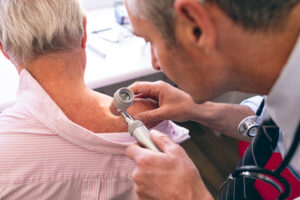Knee pain is a common complaint among veterans seeking Veterans Disability compensation. Often this leads to Compensations and Pension (C&P) exams. These exams play a crucial role in determining the eligibility and extent of benefits for service-connected knee conditions. So let’s explore what individuals can expect during a knee pain C&P exam, covering various aspects such as the types of knee disabilities, and the examination process.

Types of Knee Disabilities
Before delving into the examination process, it’s essential to understand the various knee conditions that may be considered for service connection. Some examples include patellofemoral pain syndrome, meniscal tears, knee arthritis, ligamentous injuries (e.g., ACL or MCL tears), and posterior cruciate ligament (PCL) tears. These conditions can be service connected on a primary or secondary basis, depending on the circumstances.
Primary Service Connection
A primary service connection occurs when an injury during military service directly leads to a knee condition or the worsening of a pre-existing knee injury. This connection might be established even if the injury was not documented in the service treatment record, with supporting evidence such as buddy letters or occupational exposures.
Secondary Service Connection
Secondary service connection involves a knee condition that is caused, worsened, or aggravated by another service-connected disability. For instance, a long-standing left knee condition may lead to a new disability on the right knee due to altered gait or weight distribution.
Other Considerations
Factors like occupation (e.g., paratrooper, infantryman) and weight gain can also contribute to knee disabilities. Excess weight can place additional strain on the joint, leading to deterioration or the development of conditions like arthritis.
The C&P Exam Process
Scheduling the Exam
After filing a claim for VA disability related to a knee ailment, individuals will receive a packet specifying the exam details. This includes the location, time, and information about the medical professional conducting the examination.
The Disability Benefits Questionnaire (DBQ)
The heart of the C&P exam is the Disability Benefits Questionnaire (DBQ). This document guides the examiner in gathering essential information to help adjudicators determine the appropriate disability rating. Veterans can find the knee DBQ on va.gov. The DBQ covers various sections, including diagnosis, history, range of motion, and additional factors contributing to disability.
Range of Motion Examination
A crucial aspect of the exam is the measurement of the knee’s range of motion. Examiners use a goniometer to assess the degree of flexion and extension. Active and passive range of motion is evaluated, with the latter involving the examiner moving the joint to assess any limitations or pain.
History and Flare-ups
Veterans are asked to describe the history of their knee condition, including onset and course. Additionally, they should report any flare-ups, detailing the impact on daily activities and functional loss during these episodes.
Muscle Atrophy and Joint Stability
Examiners assess for muscle atrophy, particularly in areas around the knee. Joint stability is evaluated, focusing on factors like ligamentous tears, the use of assistive devices, and recurrent patellar instability.
Surgical Procedures and Diagnostic Testing
Details about past surgeries, if any, and diagnostic testing are crucial components. This includes information on the type, date, and location of surgery. Diagnostic tests, such as imaging studies, provide additional insights into the knee’s condition.
Functional Impact and Employment Setting
The impact of the knee condition on daily life and employment is explored. Questions about standing, walking, lifting, and job-related activities help determine the functional impact and potential work limitations.
Understanding VA Ratings
While Leah does not provide legal advice, and reiterates that it is important to follow up with an accredited legal professional for guidance, it’s essential to touch on the potential ratings associated with knee disabilities. The 38 Code of Federal Regulation outlines different diagnostic codes for various knee conditions. Ratings may be assigned based on limitations of flexion, extension, instability, and the presence of knee replacements (total or partial).
Conclusion
In conclusion, veterans undergoing a knee pain C&P exam should be prepared for a thorough evaluation of their condition. Understanding the components of the exam, from the DBQ to range of motion measurements, can help individuals actively participate in the process. Seeking professional advice and ensuring accurate documentation of the knee condition’s history and impact can be crucial steps in navigating the VA disability claims process. Remember, every individual’s experience may vary, but being informed and proactive can contribute to a more comprehensive evaluation.
Also read: Obstructive Sleep Apnea and Neck Pain in Veterans Disability
At Prestige Veteran Medical Consulting, a veteran-owned company, we specialize in Independent Medical Opinions (IMOs) known as Nexus letters.
Our purpose is to empower YOU, the veteran, to take charge of your medical evidence and provide you with valuable educational tools and research to guide you on your journey.
Understanding the unique challenges veterans face, our commitment lies in delivering exceptional service and support.
Leveraging an extensive network of licensed independent medical professionals, all well-versed in the medical professional aspects of the VA claims process, we review the necessary medical evidence to incorporate in our reports related to your VA Disability Claim.
Prestige Veteran Medical Consulting is not a law firm, accredited claims agent, or affiliated with the Veterans Administration or Veterans Services Organizations. However, we are happy to discuss your case with your accredited VA legal professional.













